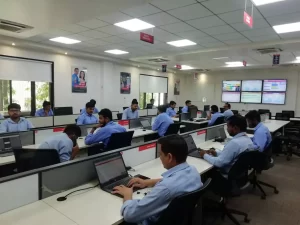Eicher Trucks & Buses, a business unit of VE Commercial Vehicles (VECV), has been making remarkable strides in the Indian CV industry by revolutionising its service ecosystem and playing a leading role in delivering ‘Uptime’ to its customers – a crucial factor to ensure higher utilisation of vehicles in today’s time-bound business requirements.
The Eicher Trucks & Buses unit was the first CV manufacturer in India to recognise the increasing importance of maximizing fleet uptime and addressing customer needs promptly, leading to the establishment of the ‘Uptime Centre’ in 2020.
The ground-breaking initiative connects Eicher’s entire range of BS-VI trucks and buses to its state-of-the-art Uptime Centre in Pithampur, Madhya Pradesh.
With the motto to be with the customer “Har Qadam, Har Waqt” , Eicher has invested substantially to address the industry’s long-standing challenges and has pioneered next-gen service solutions like remote and predictive diagnostics through its 24X7 Uptime Centre.

Through a range of modern, connected, and reliable products backed by holistic Uptime services, the company is now able to deliver >98% Uptime in all major transport segments across India.
VECV’s Executive Vice President and Head of Customer Services and Network Strategy, Ramesh Rajagopalan says: “The Uptime Centre is a valuable asset for the VECV. It has helped us to improve uptime and efficiency for our connected trucks and buses, and it has also helped to improve customer satisfaction.”
“As the automotive industry becomes more data-driven, one can expect to see more fleet operators implement similar uptime management systems as it improves the uptime and efficiency of their vehicles,” he asserts.
The Uptime Centre is a system for making decisions based on data. It keeps track of how well vehicles are working, identifies potential problems, and offers preventive maintenance, technical, service, and spare part help as soon as possible. It also keeps track of how long it takes to service and maintain vehicles. If it takes longer than expected to fix a vehicle, the Uptime Centre will talk to the mechanics about it. The process is managed online by around 200 engineers and call centre executives, round the clock, by tapping into data from a variety of sources, including vehicle telematics, service records, and driver reports.
It is seamlessly integrated with Eicher’s rapidly expanding nationwide dealership and workshop network, which comprises over 800 touch points and includes sales and service outlets on-site, support locations, parts retailers, and trained technicians across all the major highways of the country.
The company has also so far been able to map at least 4,400 odd technicians, classifying them as learners, performers, experts, and masters based on the levels of their skills and experiences.
At any given point in time, about 70% of them fall under the performer, expert, and master categories, with the remaining 30–35% falling into the learner category. “We know whom to assign a specific task to,” Rajagopalan elaborates.
“With BS VI and the fully connected vehicles, we were able to move towards the pro-active method. A lot of technical information comes to us from the vehicle and we process it in a way that we are able to predict the failure. We can thus call the customer and tell him of the possible failure of the vehicle and that we would like to attend the vehicle,” he explains.
“We have a complete an end-to-end solution. We pass on the call to the nearest dealership and to our mobile service van, which is also equipped with our telematics system. The essence here is time. We have to fix the problem. We send the technician with the right part to fix the problem,” Rajagopalan adds.
“Many times when the vehicles are getting serviced at the dealership, the technician may not be competent enough to solve the problem all by himself. He needs help. So through the app (My Eicher) he can call the Uptime Centre where it takes over. They do the trouble shooting on behalf of the technician. They will ask a few more questions to the technician to check a few parameters. With that information we help the technician to fix the problem. The idea is that we use the collective wisdom of the group rather than leaving it to one technician who may have certain limitations. This is the power of using the data, the power of using collective intelligence, so that we can offer the best services to the customer,” he asserts.
Entire system connected
“All our dealerships are operating on our same IT system, like the way banks are connected. That is the nerve centre for us. All our mobile service vans are also connected to the Uptime Centre. The connection is done by a telematics device. It’s like a mobile phone that is attached to the vehicle itself. It’s a small plug on device that has a SIM card and is connected to the mobile network. There is a module that is communicating to us. it can also communicate to the vehicle. The vehicle has an ECU, so the information related to parameters which are displayed on the vehicle’s dashboard like speed, fuel level, oil level, oil pressure is also fed into the telematics device from where it can be extracted when required,” Rajagopalan explains.
“All telematics devices work on the same principle… but what’s different is there are sensors and intelligent methods to predict the problem. For example, if the engine overheats, I will measure the temperature and the oil level and I will say that there might be a problem. So, intelligence is what we bring to the table as a manufacturer and as an Uptime Centre team. Currently, we have a mapping of every customer and their driver. We have a database. Against every vehicle, we have the owner’s contact number, the driver telephone number, etc. The first call goes to the driver while the SMS goes to the owner. We have a good call through rate. Around 85 to 90 per cent of the time, we are able to speak to the right person and are able to communicate the problem. Some (problems) can be resolved immediately while some can be resolved at our dealerships. When there is a problem, we need to be the best guy that he (vehicle owner or driver) can reach out to. When there is a problem likely to happen, they (vehicle owners or drivers) appreciate someone is calling up and supporting them. We do not want to make drivers engineers. The idea is to put the vehicle back on the roads as early as possible,” he adds.

Real-time support
“Our expert team is well-equipped to proactively monitor the vehicle’s data to predict potential failures before they occur irrespective of time and place. The team attends to more than 5500 queries every month,” says Abhishek Jakhotia, Head – Uptime Centre, VECV.
The Uptime Centre initially focused on six services – remote diagnostic services, parts-related support, Eicher on-road service (during breakdowns etc), field support, vendor support and onsite services. But now, it is equipped with three more services – predictive diagnostic services, live support and data analytics.
The data also comes in handy to convince prospective people who intend to invest in VEVC dealerships. “We can tell them about the vehicle population, movement of vehicles and assured business available for them. For existing dealers, a click of a button will provide a list of the vehicles moving around their area – within 25 or 50 km – and they can initiate service activity, thereby increasing its business prospects,” Jakhotia explains.
Working on data
Data collected by the Uptime Centre also helps the company’s product development team to effect improvements in order to offer dependable trucks. VECV has also been able to penetrate faster into new geographies. Based on the data collected, the company could map the areas of goods movement and establish containerised workshops in those regions, the northeast in particular. These workshops are attached to mobile service vans, which play a vital role in providing service support to trucks that ply on highways in NE regions.
Huge potential for growth
At Eicher, “we have seen significant traction in the long-haul segment. Our customers appreciate our modern trucks and buses which are backed by our commitment to Uptime. For the past three years, all Eicher vehicles have been equipped with connected telematics, enabling us to deliver uptime to our customers. Looking ahead, we are confident that several factors will drive the demand for long-haul transportation services. These factors include the robust economic recovery of the country, substantial investments in infrastructure, the implementation of the Logistics Policy and Gati-Shakti, and continued emphasis on initiatives such as ‘Make in India’,” Rajagopalan asserts.
Eicher is setting new benchmarks in providing a “superior uptime experience with our suite of connected services, competent manpower, and an ever-expanding network across the country. All of Eicher’s long-haul trucks are 100 per cent connected and supported by an industry-first Uptime Centre offering remote and predictive diagnostic services”.
Prominent projects like the Ganga Expressway and Gati Shakti, along with construction work on major national and state highways, have fuelled the growth of long-haul trucks and buses.
Continued economic growth is expected to drive increased demand for goods and commodities, resulting in higher volumes of long-haul freight transportation.
As the Indian economy expands and global trade flourishes, the reliance on HDTs for the efficient movement of goods across regions and countries will see strong growth.
Further, infrastructure investments in roads, highways, and logistics hubs will drive an increase in efficient long-haul freight transportation. The improved infrastructure connectivity will enhance the efficiency and accessibility of HDT operations, driving the demand for their services, he adds.
Eicher app supports
An innovative and intelligent telematics system delivered through a convenient MyEicher app supports vehicle owners and drivers to keep track of fuel consumption, maintenance needs, and fleet monitoring.
Technologies like Eicher’s MBooster+ allow the driver to drive in different modes of load and gradient to achieve best-in-class fuel efficiency and the cruise control maintains speed/rpm without pressing ABC control pedals which leads to fatigue-free driving and higher fuel economy.
The fuel coaching personally guides the driver towards the right selection of gear and rpm to help achieve higher fuel economy.
Through the industry-leading MyEicher app, the company provides fleet management software that integrates with telematics systems. This allows fleet managers to analyse data collected from the trucks and gain insights into fuel consumption, engine health, maintenance schedules, and driver behaviour.
Through Eicher’s telematics systems, trucks can transmit relevant diagnostic data to a central platform. Fleet managers or service teams can remotely access this data to monitor the health of the vehicles, identify potential issues, and proactively schedule maintenance or repairs. This helps in reducing downtime and maximising uptime.
Eicher today is setting new benchmarks in providing a superior uptime experience through an ever-expanding service network.
The company offers onsite repair, training, and prompt part delivery as part of its end-to-end truck support. Both small and large fleet owners can take advantage of Eicher’s competitive annual maintenance contracts.
Eicher trucks and buses have always ensured to provide best-in-class products backed by innovative solutions such as superior Uptime. We have a robust product portfolio in the light, medium and heavy-duty range, starting from 4.9T to 55T catering to the varied needs of customers.
Eicher has sets up a new benchmarks in providing a superior uptime experience on the back of connected services, competent manpower, and an ever-expanding network across the country.
Today, the ‘Eicher Live’ and the MyEicher app are India’s most comprehensive telematics solutions for enhanced productivity and increased profitability, available as a standard fitment across the HD portfolio.
The focus is on optimising resource use, incorporating innovative utility management systems and energy efficiency measures. “Our Smart Support Solutions provide a bouquet of services throughout the vehicle’s lifecycle that ensure higher productivity and efficiency of not only the vehicles but also the drivers, further reducing their collective carbon footprint,” Rajagopalan elaborates.